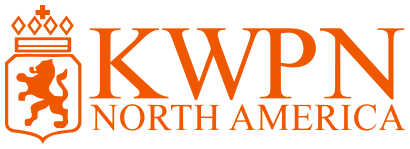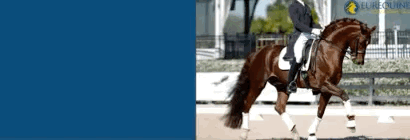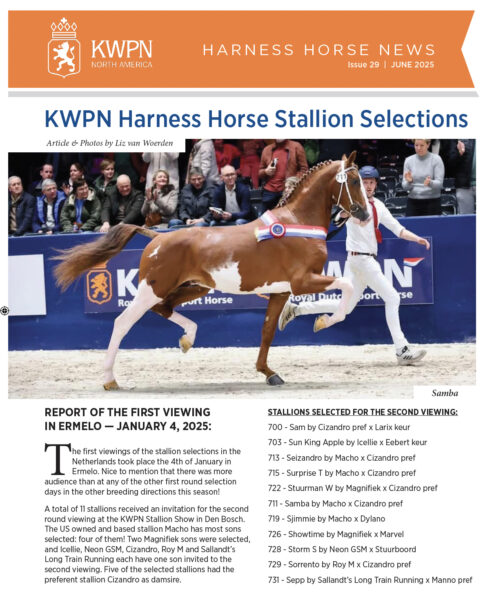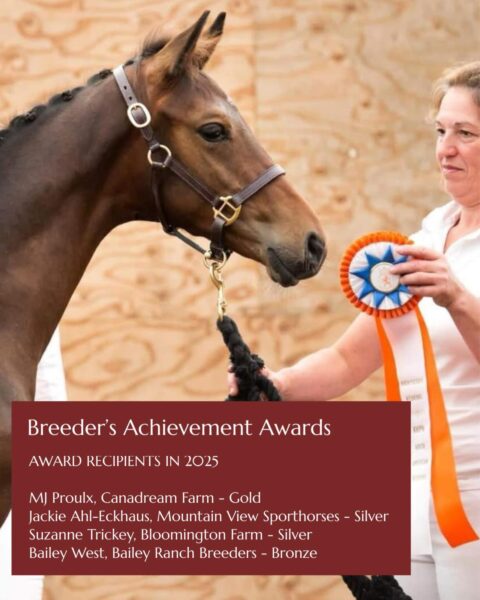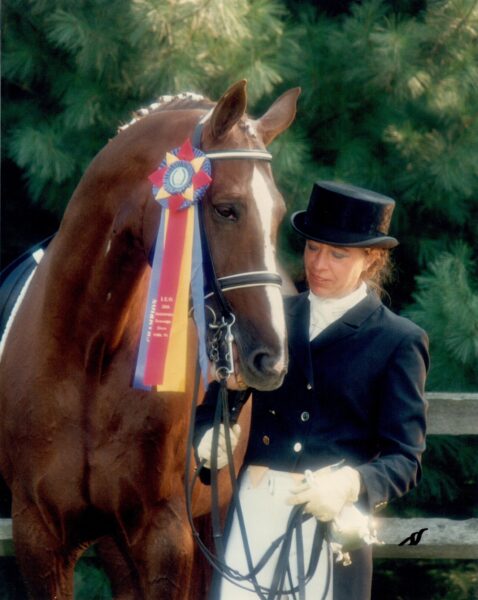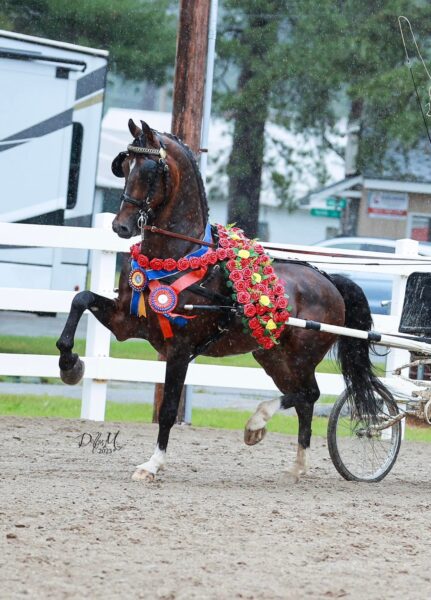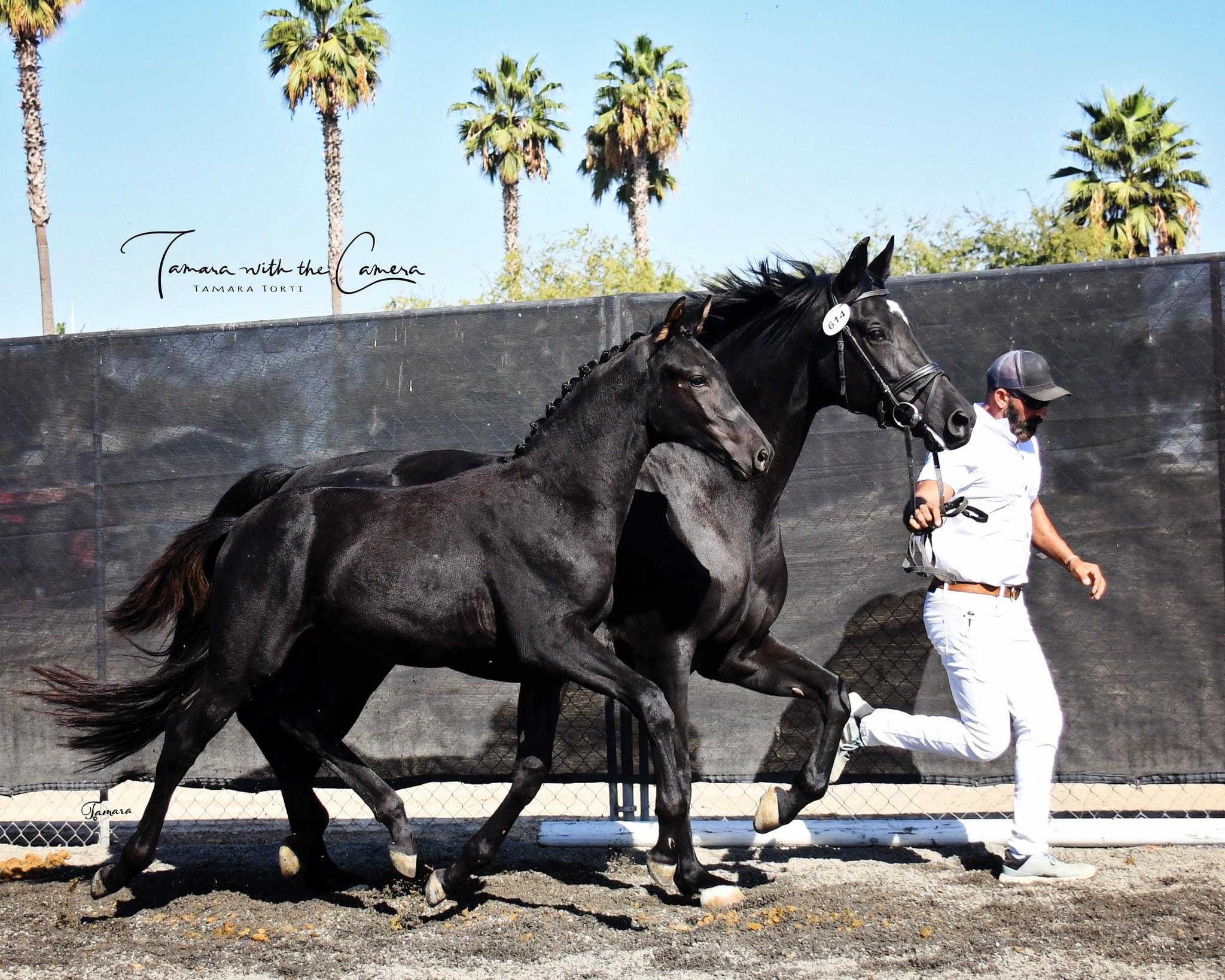
21 Jun The D-OC predicate explained with questions & answers
News
Home » News » The D-OC predicate explained with questions & answers
June 21, 2023
The D-OC predicate explained with questions & answers
D-OC: What does it mean?
In 2016, the KWPN introduced the ‘genome breeding value for osteochondrosis’, which reflects the horse’s genetic predisposition compared to the current KWPN population. In combination with this, a predicate has been developed for horses that inherit average or better than average with regard to osteochondrosis. This predicate is called the ‘D-OC predicate’ and is issued to horses with a genome breeding value OC higher than 95. Since its introduction, many questions have come in on this topic. Below you will find the answers to the most frequently asked questions. Is your question not listed? Please contact the office.
Osteochondrosis (OC)
Osteochondrosis (OC) is a common joint disorder in which flattening can occur due to a disturbance in the ossification process from cartilage to bone. If there is a loose piece of bone, we speak of OCD. Osteochondrosis can cause pain and lameness. Reducing OC is of great importance in the context of sustainability and well-being.
Let’s start with a brief explanation of how the genome breeding value works exactly. All hereditary characteristics of the horse are recorded in the DNA – a kind of blueprint for controlling all processes in the body. Our body – and therefore also that of a horse – consists of billions of cells and DNA can be found in every cell: a molecule with DNA codes on it that are unique for every human being and animal. The DNA is the most important carrier of our hereditary material and ultimately determines what color eyes or hair we get, and in horses, for example, what color or disposition they inherit from the parent animals. The spiral DNA strand consists of genes, and the total package of genes – or all the DNA together – is called the ‘genome’ of the horse. Genome selection therefore means that the composition of this genome is examined during the selection of the horse. This makes it possible to identify which genetic material is present in a better or less good variant for certain characteristics (performance, health, conformation). Genome selection on osteochondrosis maps this to this abnormality: it shows whether a horse is more or less likely to pass this on to its offspring. This is expressed in a genome breeding value in which all information about the DNA of the horse and its relatives is brought together and compared with the average DNA composition of the KWPN population. In order to perform a successful genome test in horses, they must have a certain relationship with the composition of the reference population, otherwise it is not possible to calculate a high-quality genome breeding value. For the Gelders and harness horse population, for example, this is difficult: due to selection they are increasingly distant from the current jumping and dressage horse population, which is why it has been decided by the breeding councils not to use genome selection for these breeding directions yet. However, for most Western European showjumping and dressage horse bloodlines/breeding farms it will be fine to carry out the genome test and we hardly ever see any problems.
The genome breeding value
The genome breeding value for osteochondrosis therefore reflects the genetic predisposition of the riding (jumping/ dressage) horse compared to the current KWPN population. The average of this KWPN population is set at 100. Individual horses can deviate from this in a positive or negative sense. Horses that score a genome breeding value of between 96-104 are not really deviating from the average. If a horse scores 105 or higher, it can be expected that this horse will pass on less osteochondrosis to its offspring. If a horse scores 95 points or lower, the reverse applies and the chance is greater than average that he will pass on osteochondrosis. The KWPN has developed a predicate for mares and stallions that score average or better than average on the inheritance of osteochondrosis. This predicate is called the ‘D-OC predicate’ and is issued to horses that score higher than 95.
Reference population
To be able to calculate a good genome breeding value, you must be able to make a comparison between the composition of the DNA and the trait you are interested in, in this case OC. You then make a so-called prediction equation. This comparison is developed by marking a horse’s DNA at no less than 70,000 points and linking the results to the X-rays of the animal. Doing this on large numbers of horses eventually reveals a pattern, from which a comparison between the DNA points and the degree of OC emerges. The horses that are used for this research and thus for the preparation of this comparison are called the ‘reference population’ and thus form the basis of the genome research. The KWPN put together this reference group in 2016, which then contained about 3,000 horses. It is important to keep this reference population up-to-date and close to the current breeding population, in order to be able to estimate the genome breeding value as reliable and accurate as possible. Every year, this population is expanded with about a hundred horses of the youngest generation and with bloodlines that are common in the total population, but are even less present in the reference population.
| D-OC | 95 or lower | 96-104 | 105 or higher | |
| Score means: | Horse passes OC on to his offspring more than average | Horse has an average score | Horse passes OC on to his offspring less than average |
Questions & Answers
Is it known what percentage of the foals score above 100 per year?
100 is the average of the KWPN population. In principle, therefore, 50% will score above and 50% below 100.
My mare has OC in her hind legs, she received a 1 and 2 on her X-ray. The vet said it’s minimal. I am very curious if she even qualifies for the D-OC predicate?
OC and also OCD, in which there is a loose bone fragment – can have various causes, such as unfavorable nutrition, too little or wrong exercise or a trauma/accident. However, it can also have a genetic cause, which cannot be judged from an X-ray. That is also the weakness of an X-ray examination for breeding purposes, because it does not map out whether the horse inherits osteochondrosis. In order to map this out, you therefore need research into the genetic predisposition of the horse: the genome breeding value study. The cause of the OC may be non-genetic, as described above. Your mare can therefore certainly qualify for the D-OC predicate.
Do you recommend to approve PROK or D-OC?
That depends on your goal: do you want to know whether the horse in question is OC(-D)-free (for example for sale for sport) or do you want to know what the chance is that your mare will pass on osteochondrosis to her offspring? It is important for breeding to identify the genetic risks associated with OC inheritance. With the D-OC predicate you will receive much more and more reliable information than with the PROK study. The D-OC, or rather the underlying genome breeding value, is up to three times more reliable than a PROK study for breeding purposes. If you make a breeding decision based on D-OC, then that will be about 45 to 50% reliable, if you do that based on PROK, then you will only be around 15%. PROK is a snapshot of the horse: the photos may be good today, but not in a month, because the horse has suffered a trauma, for example. This probably has no genetic cause, but you can no longer obtain the PROK certificate. The genomic breeding value can make a distinction here, because it looks at the DNA and whether or not the horse is sensitive to OC and can possibly pass it on to his or her offspring. If you are curious whether the horse can continue its sport career on its own, or whether it is good enough in the photos because the horse is intended for sale in the sport, then it is of course better to take photos, because that says something about the status of the horse yourself. However, if the horse has to be sold for breeding, we recommend requesting a genome study.
Our mare has a genome breeding value of 93 (46%). Can we breed with her?
Yes, the genome breeding value only maps out the inheritance of osteochondrosis. You can take this into account when choosing a stallion. If a mare comes from a top line with a lot of sport, but she scores a little lower on the genome breeding value for OC, you may want to use this mare for breeding anyway, because she scores well on the most important trait: sports. Since all stallions also have a genome breeding value, you can choose a stallion that scores well on OC (so has a higher D-OC breeding value). You can also choose a stallion that has been PROK approved, but it is important to realize that PROK does not automatically mean that the stallion is completely OC-free. Research has shown that the offspring groups of several PROK-approved stallions show very large differences in the occurrence of OC. PROK was the best we could do in the past, but with the selection on DNA we can now do much better for breeding!
How many horses receive the D-OC predicate?
About 70% of the horses tested receive the D-OC predicate and therefore have a genome breeding value of 96 or higher.
Where can I find the genome breeding value of the stallions?
The genome breeding values of approved and recognized stallions can be found in the KWPN Database. After looking up the stallion, you can find it under the heading ‘genetic profile’ and then it is listed under the characteristic ‘OC health (GFW)’.
In the D-OC article you indicate that it is best to choose a stallion with an OC genome breeding value of more than 104 if this is a point of attention for the mare. I always look at the value below the genetic profile and always thought that the value below 100 was more favorable than over 100. Is this wrong thinking?
Which score is favorable or unfavorable strongly depends on the characteristic. A sport breeding value below 100 is for example less favorable than one above 100. The meaning of the value is always stated with the relevant characteristic (low versus high). If a mare scores 95 points or lower for OC, this is certainly a point of attention and it is therefore best to choose a stallion that scores very positively on the inheritance of osteochondrosis, preferably a stallion with a score of more than 104.
How is it possible that I cross a PROK mare with a stallion with a genome breeding value D-OC of 100 and get offspring that also score 100, while a cross with another stallion with a genome breeding value of 102 produces an offspring with a genome breeding value of 98?
A PROK mare does not guarantee an OC-free foal, the D-OC is more reliable for breeding purposes. It is just not the reality that offspring is always the average of the parents, so when a mare has a genome breeding value of 100 and a stallion of 102, it is certainly not said that the foal will score 101. In determining the genome breeding value, the DNA composition of the foal itself is taken into account. The foal inherits 50% of the gene material from the father and 50% from the mother. But which genes these are exactly is always pure random of nature. That is why full brothers and sisters can differ so much from each other, because endless mixes of genes are possible from one and the same stallion/mare combination. But the chance of a favorable ‘pick from the gene mix’ is greater if the parent animals themselves have a positive gene package.
Which predicates can a mare apply for with a good D-OC assessment?
A Keur mare can become elite with both the PROK predicate and the D-OC predicate.
My mare has the ster and sport predicate. She is a register A-mare, so if I pass the D-OC predicate, is she then elite? Or does she have to meet additional requirements, and if so, which ones?
A mare becomes elite if she has obtained the Keur predicate and the PROK or D-OC predicate. Additional requirements may apply to a register A mare. If the sire of the horse is not PROK-approved, then an additional assessment of navicular bone photos must take place on the mare herself.
In the case of your mare, it therefore depends on the sire of your horse which requirements it must meet. In any case, your mare will first have to obtain the ‘Keur’ predicate. This can be done by registering her for a keuring. If the PROK or D-OC predicate (whether or not supplemented with navicular bone photos) is already present at the time of the Keuring and your mare meets the requirements for the Keur predicate, she will automatically become elite.
The fetlocks are photographed during the PROK investigation, but the assessment of the fetlocks is not taken into account when obtaining the PROK certificate. This seems to be done with the D-OC predicate. Is this correct?
That is indeed correct. Extensive scientific research has been done into the added value of fetlock assessment. This has shown that the fetlocks say something about the predisposition to OC as a whole. Genetically, we find a relationship between the occurrence of OC in the fetlocks and the occurrence of OC in the hock and knee. Taking the fetlocks into account therefore provides extra measuring points and therefore extra information, which makes the research more reliable.
For sales, the D-OC predicate is worth nothing. A top mare and a top stallion can still produce a ‘scrap’. Crossovers in genetic material also regularly occur in humans. So D-OC will never replace x-rays for sport. Crossing over creates new combinations of genes, and nature determines which part of the hereditary material is passed on to the offspring. These can be the better genes, but also the lesser ones and all combinations in between. Similarly, you are not guaranteed to get a Grand Prix horse by crossing a Grand Prix stallion with a Grand Prix mare. With regard to the D-OC predicate, this was also not developed with a view to trade and is therefore not a substitute for X-rays taken for this purpose. You can compare the PROK inspection based on X-rays to a PPE inspection: this says something about the horse itself. Do the X- rays show any obstacles to a future sports career? Genome selection provides information about the inheritance: is the chance average, greater or less than average, that the horse will pass on OC to his or her offspring?
How can an entire mare line be PROK approved, including the mare herself, and still not have good D-OC breeding values?
The PROK predicate does not always mean that the mare is OC-free. In consultation with veterinarians, classes B and C (flattening) are allowed in some places in the hock and knee during the PROK inspection. In the genome breeding value, however, this remains a form of OC and is taken into account as such. In addition, it is possible that the genetic predisposition was certainly present, but that the mares never developed OC themselves due to good management (feeding, exercise, etc.).
If I understand correctly: you can have a horse that has a D-OC predicate, but that is not OK on the X-rays. Is my statement correct?
Yes that’s right. D-OC says nothing about the X-ray status of the horse itself, but about the likelihood of passing OC on to his or her offspring.
Does it still make sense to have a horse PROK inspected if the D-OC values are insufficient?
Not for breeding purposes, but for sport or sales. In addition, a mare with the PROK certificate can also obtain the elite predicate.
How much sense does it make to redo a genome breeding value testing? How quickly do these values change?
In breeding, we naturally try to aim for less OC in the population, so that it becomes healthier per generation. In short: the population average will change. The breeding values will therefore move along with this, including the breeding value of the individual horse in relation to the average of the population, because this will automatically change as well. That is why a recalculation takes place every year, just like for other characteristics such as sport and conformation. However, the changes will differ minimally between two years, because things are simply not going that fast. Only if a lot of information has been added for a mare or stallion, it can sometimes change a bit more, but that will be 3 to 4 points at the most, and the reliability will of course also increase. The breeding values of the approved and recognized stallions are published every year in the KWPN Database. If you have already requested genome testing for your horse yourself, you can contact the KWPN to ask for the most up-to-date genome breeding value. If you have a horse for which you did not have the test carried out yourself, you can request this via the previous owner or request a new test yourself via the office.
How is it possible that the D-OC breeding values can always change?
The genome breeding value for OC is the value of the individual horse in relation to the population. In breeding, you assume that you are improving in the population, because we select against osteochondrosis. So in principle the quality of the population improves per generation. We also continuously supplement the research population with new, young horses in order to maintain a representative average. Because the population changes, fluctuations may therefore be possible if you look at the breeding value, but these will be relatively small.
How reliable can the research be if it concerns 23% of all OC cases and only 30% (perhaps it is now a different number) is certain?
This interpretation is not entirely correct. The characteristic is hereditary for 23%, which means that all differences that we see between the horses for the characteristic osteochondrosis can be explained for 23% by the genetic predisposition of the horses. The remaining 77% is determined by other factors such as incorrect nutrition, too little or wrong exercise, trauma, etc. 23% seems little, but we are talking about a lasting effect: the improvement is embedded in the foal’s DNA who can also pass it on to his or her descendants. This is how you improve your mare line in concrete terms. The 30% concerns the reliability of the genomic breeding value. This is the minimum, we use the test results from 30%, but it goes up to 70, 80%. The reliability is on average 45 to 50%. A reliability of 100% is not realistic, but of course we want the highest possible reliability. The alternative, only x-rays of the horse itself, offers a confidence level of 15%. Compared to that, 45 to 50% is quite an improvement.
It is therefore better to focus on the 77% that causes OCD: nutrition, exercise and rearing. Those factors are certainly also very important, but what you improve through the foal’s DNA can be passed on to his or her offspring. This is how you improve your mare line in concrete terms. This does not apply to the other factors that together make up that 77%. Because if you feed the mare well, but not the foal, then that profit is gone. The other factors therefore only apply to the horse itself, while an improvement in the DNA really becomes fixed and can be transferred to the next generation.
The degree of heritability is 23%, must this come from both parents or from one parent, so a form of recessive or dominance. The inheritance of OC is not the same as, for example, that of WFFS, which is caused by a single gene that can therefore come from either parent. OC is determined by several genes, which also makes inheritance more complex. This cannot be said to be recessive or dominant. It is of course the case that when a stallion with a higher genomic breeding value is used for a mare with a low genome breeding value, you can expect that the stallion will “improve” the mare. If so, the “favorable DNA” will most likely have come from the father.
My purchased mare does have a genetic profile in the KWPN database, but no D-OC predicate. Can you also apply for a D-OC based on that genetic profile?
No, unfortunately that is not possible. The genetic profile is a breeding value for other characteristics such as sport and conformation based on, among other things, the horse’s lineage. The D-OC predicate is based on a DNA test specific for the OC characteristic, via a hair sample, which the foal inspector immediately takes during the sketching and possible chipping of the foal. For most older horses, the KWPN already has a hair sample in the archive. After registering the horse for the DNA test, the hair sample is looked up. If a hair sample is no longer available, you will be contacted to discuss the further procedure.
I think it is a great pity that the genome breeding value is not calculated for the Gelders horses. Why is this?
To be able to calculate a good genome breeding value, a so-called reference population is needed that is sufficiently large to be able to make a reliable statement about the inheritance of OC. Horses for which the genome research is subsequently carried out must be related enough to this reference population. However, scientific research has shown that Gelders horses (and harness horses) differ too much in terms of DNA composition from the jumping and dressage horses, making it impossible to calculate a high-quality genome breeding value. It is financially and in terms of numbers not possible to create a separate population for the Gelders and harness horses. It is therefore also not possible to apply for the D-OC predicate for horses in these breeding directions. The selection against OC will therefore still have to be done via X-rays for the time being.
I have a mare with a D-OC value of 97. If I use a stallion with the same value, what chance does the offspring have of OC?
The exact probability is difficult to indicate, because these are estimates. 97 is an average score, but it is on the lower end of the average. We therefore expect an average inheritance from this combination and therefore a foal that will come close to this. However, that is theoretical of course, if the mare happens to pass on all of her favorable genes and the stallion does as well, there will be little chance of OC in the offspring. But if both parents do the opposite, there is a higher chance. It should be clear that when the gene package of the parents is as favorable as possible (ie a high genomic breeding value of more than 104), the chance of an offspring with OC becomes lower. This is, of course, about the genetic variant of OC. An offspring can also get OC due to factors other than genetics, which you have no control over with breeding.
It seems that D-OC is achieved more easily/more often than PROK. Isn’t that a false sense of security?
The standards for PROK and D-OC, and therefore also the horses that may or may not pass, have been determined by the Breeding Council for Riding horses. This council of breeders has indicated that it does not want to be stricter or more flexible than for PROK and the entire system is designed in such a way that these numbers are comparable. The D-OC is achieved with a minimum breeding value of 96, but one has to realize that with this score you belong to the bottom of the average, so the actual genome breeding value (the number) is also important to include in your considerations when, for example, choosing a stallion. It is therefore not the case that D-OC is achieved more often or more easily than PROK.
This is a translation from the following article on the KWPN page:
https://www.kwpn.nl/kwpn-paard/kwpn-paard-selectie-en-fokprogramma/fokkerij/vragen-en-antwoorden-d-oc
Find the D-OC Form HERE.
Visit THIS page on our website for more information about the predicate system.

